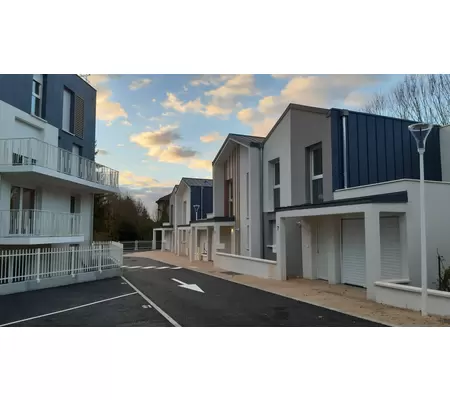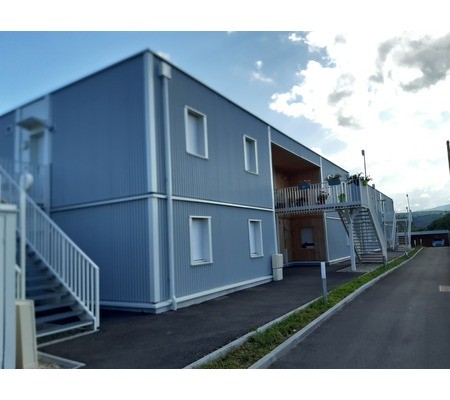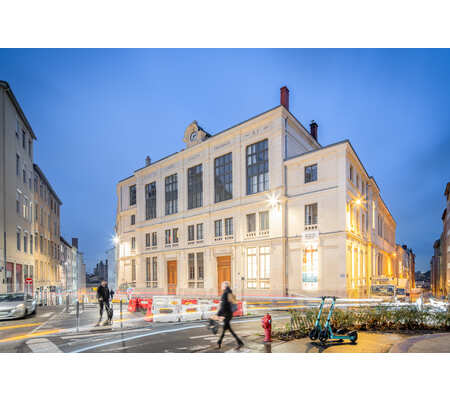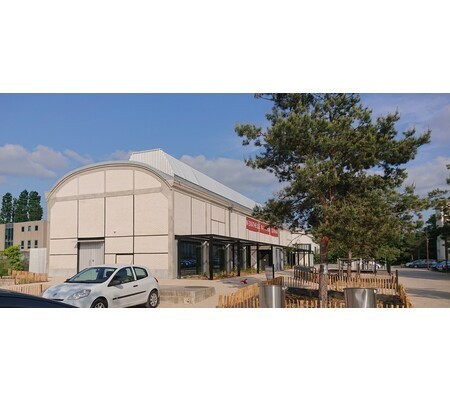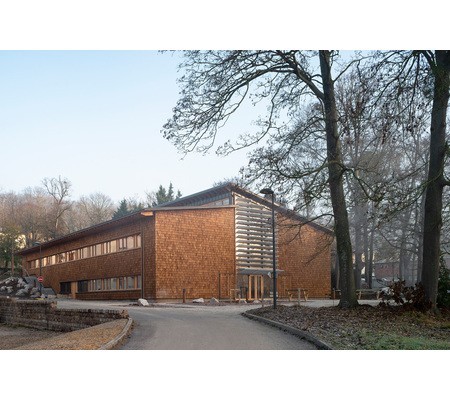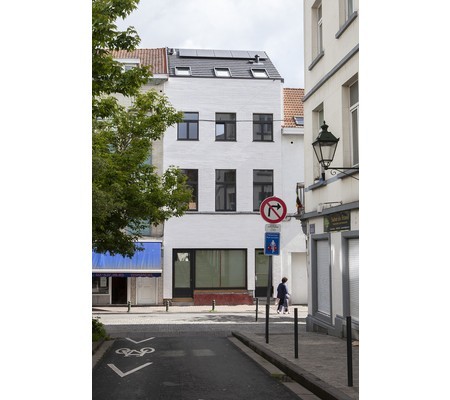Raymond Queneau library in Ris-Orangis (France)
Last modified by the author on 02/06/2023 - 19:27
Heritage renovation
- Building Type : Library, documentation center
- Construction Year : 1930
- Delivery year : 2023
- Address 1 - street : 5 rue Eugène Freyssinet 91130 RIS-ORANGIS, France
- Climate zone : [Cfb] Marine Mild Winter, warm summer, no dry season.
- Net Floor Area : 480 m2
- Construction/refurbishment cost : 2 200 000 €
- Number of Seat : 45 Seat
- Cost/m2 : 4583.33 €/m2
Certifications :
-
Primary energy need
67.23 kWhep/m2.an
(Calculation method : RT 2012 )
This new community equipment aims to be a friendly cultural place that is both a place of learning, reflection and exchanges.
It consists of three main sets:
- Spaces dedicated to the public: reception, the “Image and Sound space", the “Adults space" and the “Youth space”. From the reception, all the public spaces will be visible.
- Technical spaces;
- Mezzanine staff areas.
It is largely open to the outside. The fittings allow obvious connections between the interior and the exterior, offering the possibility of reading in a garden.
Building users opinion
The building has just been delivered, so users do not yet have much perspective on the occupation of the building. Nevertheless, they are very satisfied with the natural light provided by the place and the sun protection.
If you had to do it again?
Everything did not work according to the objectives of the project but at the cost of difficulties to be overcome:
Brick: the condition of the brick and its exact nature were very difficult to diagnose. The layers of paint and the tags as well as the interior cement coating had modified its structure, raising fears of its decay. A chemical test revealed the presence of chlorides but without giving any repair solution.
We originally prescribed a scrub, but even the finest of micro-scrubs dug into and damaged the brick. In addition, we couldn't get the layers of tags that remained on the joints removed. We arrived there by consulting a specialised company to perform mechanical sanding and the removal of the old joints manually to restore a satisfactory surface condition to this white Lardy brick, which is almost a century old. This company (FLIPO) was subcontracted by the mason (DESTAS & CREIB) dependent on lot 01 initially in charge of this service. All this search for treatment during the construction site resulted in a very big delay in the schedule. In conclusion, this service should perhaps not have been part of the Major Works lot, which is too general, but of a specific lot, in order to have professionals with the appropriate knowledge and tools from the start of the works.
The facade: the brick being laid in a simple filling bed between and on very corroded IOP irons, it is therefore not considered to be a watertight wall. We had to build the coat wall from the inside. The difficulty for the company was to deal with the air gap and to install the rainscreen “upside down”. This particularity had not been properly taken into account by the company, our documents had probably not been explained enough in the consultation file. Cleats had to be fixed on the existing cement coating on the back of the bricks to then staple the rain screen to it from inside the building. Then the thermal and acoustic linings, the partitions and the finishes could be made in the traditional way.
The concrete was very carbonated because it was badly damaged by the leaks. The entire steel coating layer has been purged, sometimes quite deeply, until certain steels have been replaced. The low thicknesses prevented any fixing in the structures or the concrete vault. The steel structure of the canopy was placed by clamping on the trusses.
The site would nowadays be unbuildable because it is too close to the railway tracks. The reconversion was therefore the only possibility to reuse this place.
See more details about this project
https://deso-architecture.com/projet/nouvelle-mediatheque-r-queneau-dans-la-grande-halle-freyssinet/BIM approach
The design studies and site monitoring were carried out in BIM on Revit.
The model was also given to the project owner, at its request, at each stage of the studies and in the completed works file.
Photo credit
Daniel Rousselot, Céline Masson, Luca Serres, Magali Lenoir
Contractor
Construction Manager
Stakeholders
Thermal consultancy agency
SWITCH
Giampiero RIPANTI, g.ripanti[a]switch.coop
http://www.switch.coop/Fluids, Thermal and Environment Design Office
Structures calculist
IN4
Bruno PERSON, b.person[a]in4-ing.fr
https://www.in4-ing.fr/Structural design office
Structures calculist
ALTIA
Erwan GOUEROU, erwan.gouerou[a]altia-acoustique.com
https://www.altia-acoustique.com/Acoustic design office
Contracting method
Other methods
Type of market
Other
Other type of market
Complete mission MOP Law
Allocation of works contracts
Separate batches
Energy consumption
- 67,23 kWhep/m2.an
Envelope performance
- 0,64 W.m-2.K-1
More information
Lighting limited to 6W/m² in electrical power, presence detection in corridors and service areas + dimmable in main rooms.
The building complies with the objectives of the BBC renovation Effinergie label.
Systems
- Urban network
- Low temperature floor heating
- Individual electric boiler
- No cooling system
- Natural ventilation
- Nocturnal ventilation
- Free-cooling
- Double flow heat exchanger
- No renewable energy systems
Smart Building
Risks
- Flooding/Slow flood
- Urban heat island
- Slab raised by 60 cm compared to the existing one with total remodeling of the public space to access it.
- Roof treated in a light color for a low albedo. Creation of a strip planted all along the building as well as a shaded reading garden in the gable. The purpose of these treatments is to weaken the heat island effect.
Construction and exploitation costs
- 200 000 €
- 2 200 000 €
Circular economy strategy
- Maximization of quantities on targeted products
- Targeting of areas
- Choice of non visible products
- Maximization of the carbon gain
Reuse : same function or different function
- Structural works
- Facades
Logistics
- On site, on a dedicated area not covered
Insurance
Environmental assessment
| facades | 14146.89 | 76.838895 | 5456.798499 |
| Big work | 13.143782 | 0.027035084 | 11.237682 |
| CO2 avoided (kg) | Water consumption avoided (m3) | Waste avoided (kg) | |
| TOTAL | 14160.03378 | 76.86593008 | 5468.036181 |
The reuse operation saved the equivalent of 113,280 kilometers traveled by a small car, or 129 Paris-Nice journeys, 512 rectangular bathtubs filled with water and 11 years of household waste for a Frenchman.
Economic assessment
- 120 000 €
- Others
Communication
Social economy
- The removal, sorting and palletising of the bricks reused in situ were handled by workers in professional integration. The same applies to the crushing of the existing concrete slab;
- One of the interior linings was made of Argilus partition, a raw earth plate;
- The thermal insulation used for the entire project (facades and in the partitions) was made of BioFib Trio.
Circular design
Comfort
Quality of life and services
The library is a communal service provided by Grand Paris Sud. Located in the heart of the Dock de Ris eco-district and near the regional train station, this facility will be a place of meeting, work and calm. The reading room is extended by a reading garden offering an intimate, calm and flowery place in the shade of a pergola to work or simply read a book.
The team in place wants to set up many events for users and residents of the neighbourhood.
The forecourt laid out all along the media library should accommodate a market.
Reasons for participating in the competition(s)
This project of rehabilitation was designed to optimise the resources of the existing building as much as possible in order to move towards frugal construction. This working method influenced the entire project and resulted in the success of the worksite and the involvement of all the companies, in particular on environmental issues. Thus, through its design, its program and the specificity of the existing hall, the project responds to the pillars of the circular economy and becomes a committed reference for the agency.
In order to limit the environmental impact, and to move towards responsible consumption of materials and energy, several actions have been implemented. Regarding the choice of materials, the reuse of bricks (including selective removal, cleaning and refitting), the choice of biosourced insulation (hemp wool, linen and cotton) and the use of raw earth partitions with an earth coating have considerably reduced the carbon impact of the building. In addition, the bioclimatic design will make it possible to limit energy consumption needs during the use of the building. For this, a free-cooling system is set up, the openings for the natural ventilation air inlet are arranged on the facade behind solar protection and low plantations in order to bring in the freshest possible air. The light-coloured coating on the roof provides a favorable albedo for the building, which will thus store less heat and have a reduced need for consumption. On the other hand, heating is provided by the heat network of the eco-district, the source of which comes from geothermal energy and a wood-fired boiler room.
These design elements that allow responsible consumption come from a work methodology oriented around eco-design. The constraint of the location, volume and compactness of the hall are dealt with the choice of breathable biosourced insulation, raw earth partitions bringing back thermal inertia for summer comfort and the installation of passive solar protection and free cooling. At the scale of the district, eco-design is reflected in the management of rainwater collected in the planted beds and the shaded garden created in the extension of the reading spaces as well as in the valleys of the forecourt. These vegetated sets thus contribute to creating an island of freshness to fight against the warming of the district.
The existing hall is a resource for the new project. The work carried out with the companies to preserve and adjust the bricks, as well as the meticulous repair of the concrete structure, gave the possibility of extending the life of the structural materials of the project. For the materials that have been added to those already present, great vigilance has been brought to their quality so as to select only the most durable materials requiring little maintenance over time. The sustainable supply also results in the treatment of the existing concrete slab which was crushed and left in place at the bottom of the backfill. This solution made it possible to avoid numerous passages of lorries, both for the evacuation of the waste and the transport of new backfill. Finally, the insulators used in the project are virtuous by their composition implementing elements from recycling. On the roof, the foamglas comes from recycled glass, while the Biofibtrio is partly made of cotton from a French recycling industry.
This library, which through its program induces an economy of functionality, is a project that highlights the pillars of the circular economy through its design and implementation with committed companies.



















